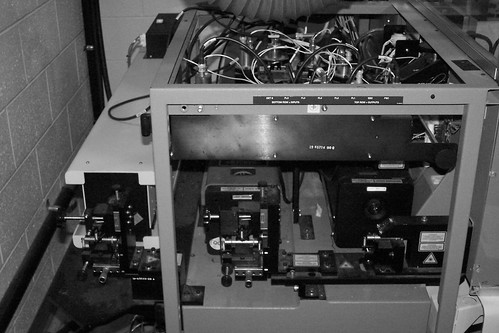
My three lasers - from left to right - the HeNe (Red) laser, Krypton (UV), and Argon (Blue) lasers. The Argon laser is the primary laser and is on all the time, the HeNe laser is on 95% of the time, and the Krypton laser maybe every six weeks or so.
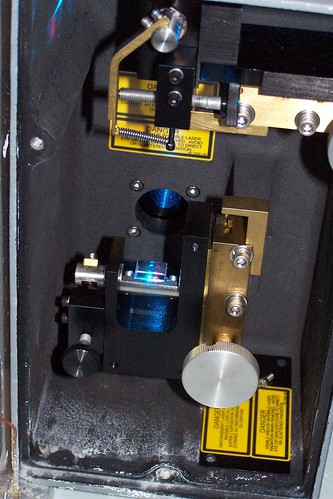
You can see the Argon and HeNe lasers here, as they enter the machine, refracting off a prism. They hit that prism and are sent up at a 90° angle, where they hit another prism, take another right turn, hit a focusing lens, and then enter the flow chamber itself. It's really a bit more complicated than that, but I don't feel like reopening the panel just now to remind myself of what all is in there and how it gets adjusted.
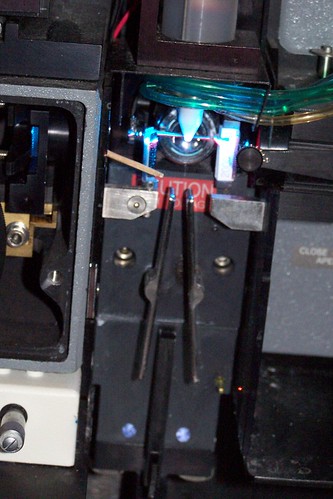
This is the flow chamber, or "interrogation point" or "where the magic happens" as I like to think of it. I've got a little piece of wood stick shoved into the override so the lasers can be seen. From top to bottom, you see the nozzle - the sheath fluid and sample comes out here - the sample itself is injected somewhere inside there, and since it's traveling at a higher speed (pressure) than the sheath fluid, it stays right in the middle of the stream (This is called "Hydrodynamic Focusing," which is an excellent word to break out at cocktail parties) where the machine can get a good, accurate "look" at it.
The nozzle itself is vibrating really quickly, via piezo crystal, at a known rate, which breaks the stream into droplets at a known frequency. I calibrate the machine so I know which droplet a cell is in at what time (this is all calculated by the computer, really, I just adjust to make sure its spot on), and give that droplet a specific electrical charge. The two metal plates you can see in the picture are oppositely charged, so that a charged droplet falling past one of them will be deflected one way or another. Inkjet printers work in the same fashion.
Where you can see the lasers reflecting is an obscuration bar - there are two optics, one straight in front of and one at 90° from the laser beams themselves- these bars block out all of the "unadulterated" laser light so that the only things being registered are photons that have glanced off of - or been emitted from - the cell in question at an angle.
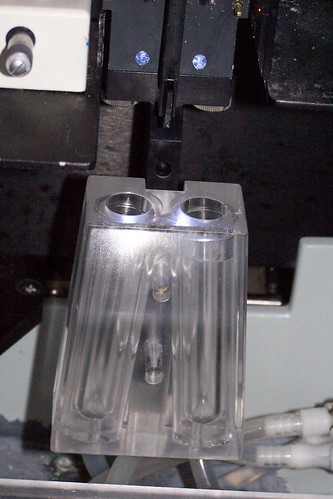
This is where the collection tubes sit - I spend a good portion of my day either: staring at this; or turning my head just in time to see that a collection tube is about to overflow and saying "Oh shit" and throwing everything into standby.
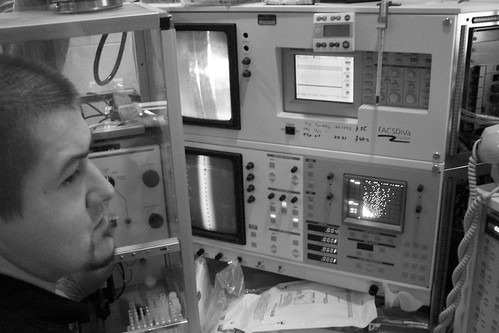
This is also where I spend a good portion of my day staring. The screens you can see are the sorter stream in the upper left hand corner - if I was sorting, you'd be able to see the side streams in the picture. I also have a small red laser that I can focus on my stream at this spot, and a filter I can put in front of the camera so that every morning I can sort some beads and adjust my drop delay - this is what I was talking about earlier w/calculating when a drop is where. It's really about as easy as any visual pattern recognition. Usually.
In the lower left hand corner of the contraption is the droplet break off stream. This camera has a strobe light attached to it that's strobing at about the same frequency as the nozzle is vibrating so that I get a static picture. I have to keep an eye on this to make sure that the droplets look normal and are breaking away from the stream at the right spot, otherwise, I mutter to myself "Oh shit," throw the machine into stand by, yank the sample and collection tubes off, and go about making things right.
The screen on the lower right is an oscilloscope that's right now displaying a bivariate plot of blue laser light that the cells are scattering.
In the upper right is another oscilloscope that shows me the frequency the nozzle is vibrating. I mostly ignore this screen.
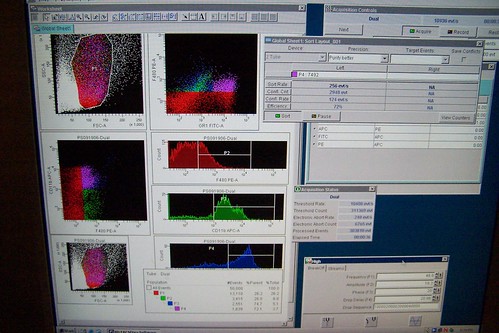
This is the final thing that I stare at all day. This is the FACSDiva software - you can see all sorts of dot plots and histograms, and the other windows I use to make some of the adjustments on the machine. There's a second screen to the left, but as it only displays file names and other things that I only have to see between samples, I have it switched over to my second computer most of the time, which is what I'm typing this on.
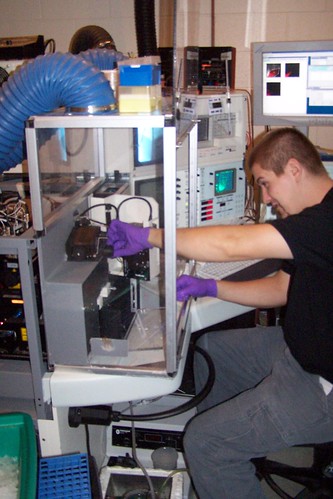
Here I am, "hard at it." And by hard at it, I mean, "being tubby."
Boring much? I'm sure I've left things out and misinformed in some cases, but that's the gist of how I spend 7/8 of my working day.
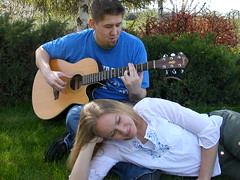
7 comments:
Excellent!
Damn, we should have gotten a picture of the beer, wings and sweet potato fries we quickly snarfed down when we finished.
Yeah. We could have gotten a picture of grinning scientists, then people would have thought that science is a good time.
Waaaaaaait a minute! You mean to tell me you work in a lab with that kind of gear and aren't trying to create mutants or give yourself super powers?!?
The hell are your priorities?
Actually, Simon and I used to talk about doing something more worthwhile - like killer robotics development or creating cool animal/human chimeras.
Chimeras....sweeeeet. You could start of with the traditional huge grasshoppers, fuzzy trout, and yes, the jackalope.
One question: why'd you quit Black Flag?
Hank Rollins' shoes were jsut too big to fill.
Post a Comment